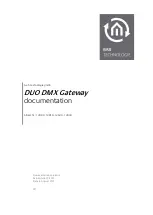
25
In the above example, an FTP Server (IP_192.168.2.2) and an HTTP Server
(IP_192.168.2.3) are connected to the Internet via WAN1 (IP_200.200.200.1) on
BiGuard 30. A remote computer is trying to access these servers via the Internet,
and makes a DNS request. The DNS request (
www.mydomain.com
) will be sent
through WAN1 (200.200.200.1) to the built-in DNS server. The DNS server will reply
200.200.200.1 because this is the only active WAN port. Should WAN1 fail, BiGuard
30 will instead reply with WAN2’s IP address (100.100.100.1), and the remote PC
will gain access to the network via WAN2. By configuring BiGuard 30 for DNS
Inbound Fail Over, incoming requests will enjoy increased reliability when accessing
your network.
Please refer to appendix H for example settings.
2.5.2 DNS Inbound Load Balancing
DNS Inbound Load Balancing allows BiGuard 30 to intelligently manage inbound
traffic based on the amount of load of each WAN connection by assigning the IP
address with the lowest traffic load to incoming requests.
Built-in DNS
192.168.2.2
192.168.2.3
FTP
HTTP
200.200.200.1
www.mydomain.com
200.200.200.1
Authoritative Domain Name Server
Before Fail Over
100.100.100.1
After Fail Over
100.100.100.1
DNS
DNS
Built-in DNS
192.168.2.2
192.168.2.3
FTP
HTTP
1st connection
2
nd
connection
1st connection
2
nd
connection
www.mydomain.com
DNS
DNS
Summary of Contents for BiGuard 30
Page 1: ...BiGuard 30 iBusiness Security Gateway SMB User s Manual Version Release 5 00 FW 1 03...
Page 46: ...46 2 Double click the Network icon The Network window displays a list of installed components...
Page 51: ...51 2 In the Control Panel double click Network and choose the Configuration tab...
Page 207: ...207 Step10 Input PPTP Server Address and press Next Step11 Please press Finish...
















































